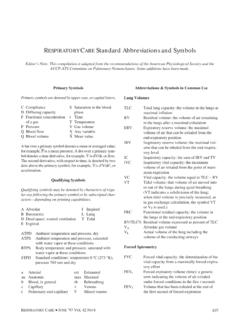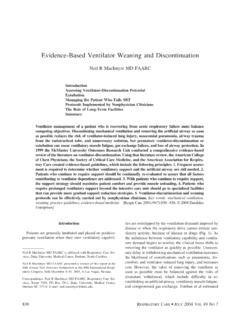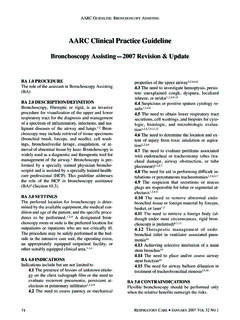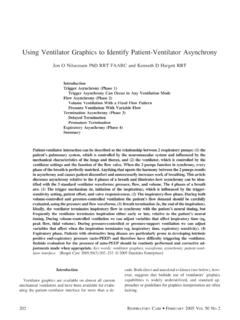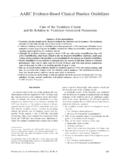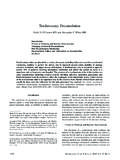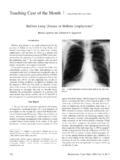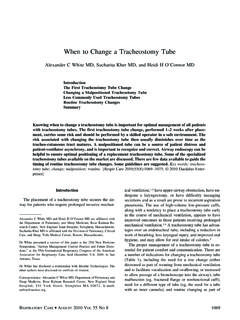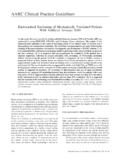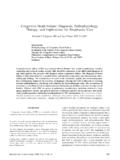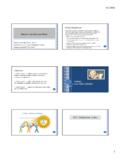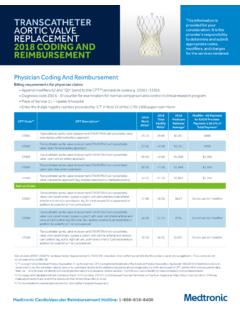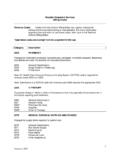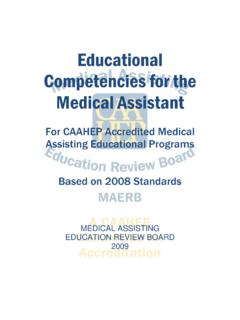Transcription of Pulmonary Function Testing: Coding and Billing …
1 Pulmonary Function testing : Coding and Billing IssuesNeil R MacIntyre MD FAARC and Catherine M Foss CPFTI ntroductionTerminologyAccreditationDevel oping Coding / Billing StrategiesSpirometryLung Volume TestingDiffusing Capacity for Carbon MonoxideAirway ChallengeExercise TestingMiscellaneous TestsSummary RecommendationsClinicians who conduct Pulmonary Function tests should understand the principles and rules of the codingand Billing system for Pulmonary Function testing . Certain Billing codes will not be paid by most insurancepayers. To ensure that your Pulmonary Function tests are appropriately coded, billed, and paid: (1) obtain aCurrent Procedural Terminology (CPT) Coding book and an International Classification of Diseases 9thRevision (ICD-9) diagnosis book, and understand how they are used in setting Coding and Billing strategies,(2) know the people in your facility who do the Billing and work with them to produce an appropriate codingand Billing strategy, (3) make sure the physicians are involved in developing and implementing your codingand Billing strategy, and (4)
2 Assure that your laboratory is set up properly to follows the Medicare rules forparticipation, that you have the appropriate testing supervision, that the appropriate administrative structureis in place to assure compliance with all regulations, and that you meet American Thoracic Society words: forms and record control, health insurance, current procedural terminology, internationalclassification of diseases, Medicare.[Respir Care 2003;48(8):786 790. 2003 Daedalus Enterprises]IntroductionPulmonary Function testing (PFT) includes proceduresthat are among the oldest in clinical medicine. Spirometrywas first described in the mid-19th century, and the tech-niques for lung volume determinations and measurementsof carbon monoxide uptake were developed in the early20th these tests were done to help phy-sicians better understand disease pathophysiology, and thecosts were simply part of the overall physician fee.
3 By themid-20th century, however, growing testing complexityand costs prompted the development of specific Billing forthese procedures. Though they were initially simple andstraightforward, Billing procedures have gotten more con-fusing for 2 reasons. First, the classical testing procedureshave evolved over the years to provide more and betterinformation. Examples include the plotting of a flow-vol-ume loop from the forced vital capacity maneuver, plottingof the gas dilution pattern during nitrogen washout, andadding exhaled gas analysis to exercise assessments. Bill-Neil R MacIntyre MD FAARC and Catherine M Foss CPFT are affiliatedwith the Pulmonary Function Laboratory, Department of Medicine, DukeUniversity Medical Center, Durham, North MacIntyre presented a version of this report at the 18th Annual NewHorizons Symposium, Pulmonary Function testing in 2002: Updates andAnswers, October 6, 2002, at the American Association for RespiratoryCare s 48th International Respiratory Congress in Tampa, R MacIntyre MD FAARC, Respiratory Care Services, PO Box3911, Duke University Medical Center, Durham NC 27710.
4 AUGUST2003 VOL48 NO8ing codes developed for the original procedures do notnecessarily reflect the complexities of these additions. Sec-ond, pressure from third-party payers to assure that onlynecessary testing is done, and only with appropriate pa-tients, has placed considerable barriers (usually in the formof Billing rules and consequent denials) to getting testsperformed and reimbursed. This is made even more com-plicated because the thousands of payers in the UnitedStates often have different and conflicting rules. A suc-cessful Pulmonary Function laboratory must therefore notonly understand the technical aspects of testing2 4but mustalso understand the nuances of proper Coding and ,6It is beyond the scope of this report to comprehensivelyreview all of the Billing rules in place throughout the UnitedStates.
5 Instead, this article provides a framework in whichto build a Coding and Billing strategy and provides someexamples of how to code and bill these procedures. Webegin by discussing some of the terminology used in pul-monary Function testing and follow this with discussion ofsome of the common Billing rules. We will use Medicareas a prototype payer system, but it is important to realizethat there are several thousand other insurance companiesin the United States, and each has its own ways of optimize Coding and Billing it is important first tounderstand the vocabulary. A few important terms to un-derstand are:Billingandpayment. Billing is the submission of a chargeto a payer.
6 Payment is what is actually received. You canbill the payer in a sensible, ethical manner, but it is thepayer s rulebook that determines ultimate codes. Disease diagnoses are commonlycoded using the International Classification of Diseases9th Revision (ICD-9) a payer to providepayment the patient must have an appropriate cardiorespi-ratory diagnosis and be assigned the appropriate ICD-9code(s).Co-pay. Payment usually does not come from just thethird-party payer. Most insurance companies, Medicare inparticular, require that the patient pay up to 20% of theallowable charge out of his or her pocket at the time oftesting (the co-pay ).
7 This generally cannot be , waiving (or discounting) the co-pay can be con-sidered fraud in that it implies that the procedure could beperformed for less than the billed code. Procedure codes are alpha-numericcodes used by billers and payers to describe institutions have their own internal set of codes forprocedures, whereas payers generally require Billing perthe 5-digit Current Procedural Terminology (CPT) codes,8a universal Coding system designed and updated by theAmerican Medical Association. CPT codes can also havemodifiers applied to clarify a bill. Commonly used mod-ifiers for PFT include -25 ( testing not considered part ofa physician evaluation); -26 ( testing and interpretationbilled separately); -51 (multiple procedures); and -59 (separate procedures).
8 In recent years Medicare has groupedthe payment rate for the various CPT codes into a fewbroad Ambulatory Patient Classification (APC) categories(Table 1). The 3 common APC groupings used for PFT are0367, 0368, and 0369. The assigned relative value units(used to calculate reimbursement) in 2003 for these 3 codesare , , and codes for PFT can be confusing because manycodes no longer accurately reflect the procedure beingdone and redundant codes have been added in attempts toreflect advancements in technology (eg, the developmentof flow sensors and graphics led to a new code for flow-volume loop [CPT 94375], even though it is the same testprocedure as spirometry [CPT 94010]).
9 Bundling and edits. Bundling refers to the payers pol-icy of considering payment for one code to be inclusive ofother codes. An example is that the flow-volume loop isgenerally considered bundled with spirometry (ie, you canbill for both, but payment will be bundled into 1 code,Table Pulmonary Function Tests*AmbulatoryPaymentClassificationCur rentProceduralTerminologyCodeTest Description036794010 Spirometry94200 Maximum voluntary ventilation (MVV)94375 Flow-volume loop94720 Diffusing capacity of the lung for carbonmonoxide (DLCO)036893721 Body plethysmography94060 Spirometry (before and after bronchodilator) 94260 Thoracic gas volume94350 Maldistribution of ventilation94360 Airway resistance94370 Closing volume94620 Simple exercise test94725 Membrane DLCO94750 Pulmonary compliance036994070 Multiple spirometries after airway challenge 94621 Complex exercise test 95070 Administration of bronchoprovocation agent *All tests require general physician supervision Requires direct physician supervision Requires personal physician supervisionPULMONARYFUNCTIONTESTING:CODI NG ANDBILLINGISSUESRESPIRATORYCARE AUGUST2003 VOL48 NO8787usually the least expensive).
10 Bundling is automatically doneby payers using edits in their computerized Billing pro-cessing systems. It is important to note that edits and bun-dling rules often differ among payers require that PFT have some form of ac-creditation to assure that good clinical and laboratory prac-tices are followed. For example, Medicare has rules ofparticipation and must be assured that the hospital or fa-cility is abiding by these rules. In general, if the laboratoryis associated with a facility that is accredited by the JointCommission on Accreditation of Health Care Organiza-tions, it meets the Medicare requirement. Physician super-vision (medical direction) is also required by the payers,but the level of supervision required depends on the test(see Table 1).
